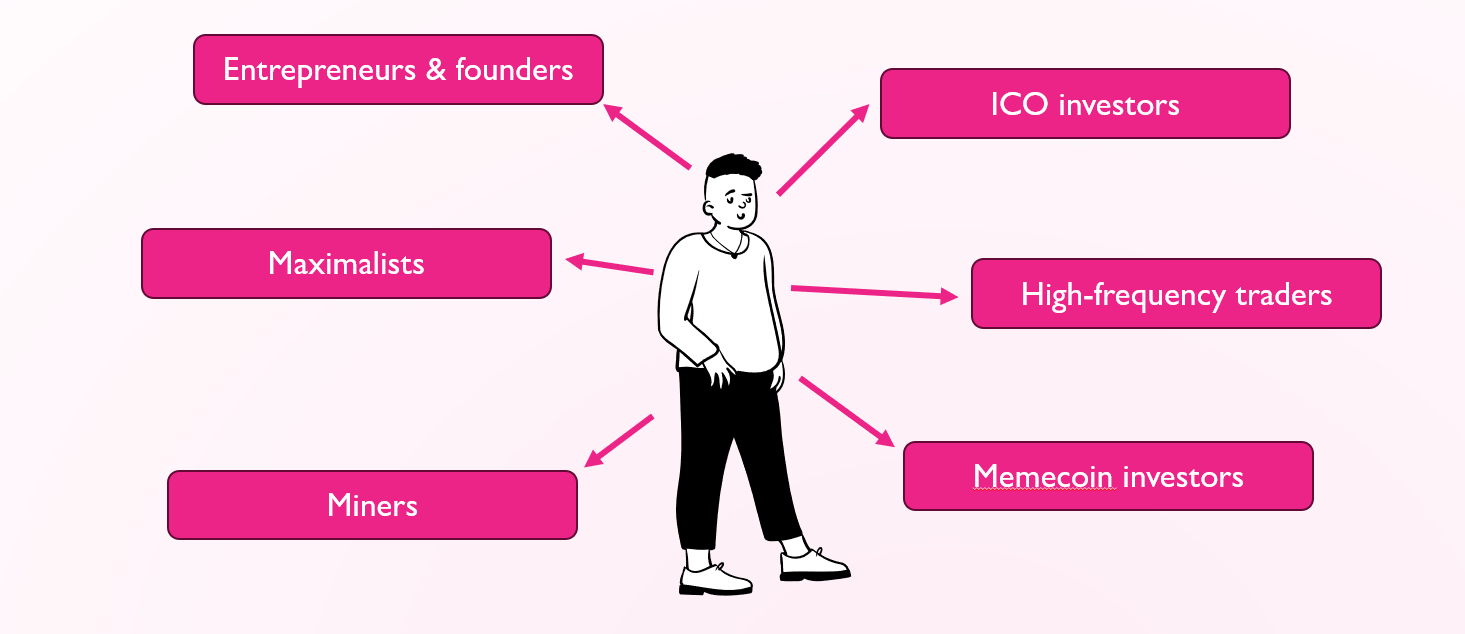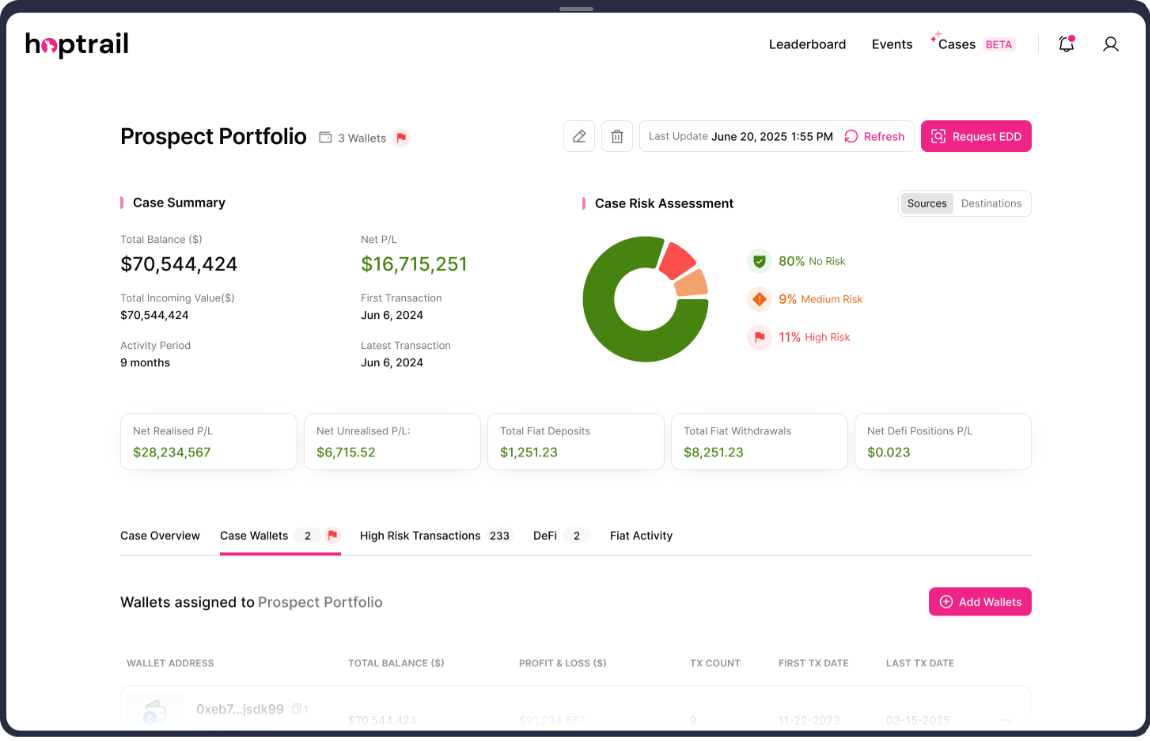Onboarding a Crypto Investor: A Complete Guide

The surge in cryptocurrency investors seeking traditional banking services presents both opportunity and risk for regulated institutions. Unlike traditional asset holders, crypto clients may have fragmented and complex records spread across multiple blockchains, wallets, exchanges, and DeFi platforms.
A well-designed onboarding process is not just about satisfying AML / KYC requirements. If done correctly, it can significantly reduce onboarding time and cost; and be used to access new business opportunities among a generation of wealthy crypto entrepreneurs.
This guide blends Hoptrail’s onboarding checklist with practical steps and tips a financial institution can take on how to create an efficient and rigorous prospect onboarding flow.
1. Crypto Wealth Narrative
A concise, documented narrative is the cornerstone of a crypto onboarding file. It provides the story against which all blockchain data can be tested; and is extremely useful for wealth analytics providers like Hoptrail to begin navigating the prospects' ecosystem. The narrative should include:
- Initial Investments - e.g., fiat deposits to an exchange, mining, or ICO participation.
- Timeline of Activity - when and how they entered (and moved through) the crypto space, and what chains and services were used over which timeframes.
- Wealth Creation - which on-chain positions (tokens, wallets, investments) generated the most wealth for the prospect.
- Liquidation History - where and how did the prospect cash out, and approximately how much wealth was generated.
Tip for banks: Crypto clients tend to be relatively good record keepers, but its rare that all data is captured up front. This isn't necessarily a red flag - gaps or missing information should be picked up during the wealth analysis stage.
2. Collect a List of Wallet Addresses
The backbone of on-chain analysis is knowing exactly which addresses belong to the prospect and how they used those wallets over time. Most prospects will have different types of wallets for a variety of different reasons. Think about the following:
- Personal (self-custody) wallets - these might be cold storage wallets (e.g. Ledgers or Trezors used to keep assets safe offline) or hot wallets (e.g. MetaMask, usually used for ongoing trading)
- Exchange deposit addresses — especially important for those venues used to liquidate funds (to assess how much wealth was exited through them)
- Protocol-specific addresses — those used for staking or liquidity pool positions.
Tip for banks: for prospects with cold storage wallets, it is useful to request their extended public key (often known as an xpub). This will contain a list of all prospects' addresses in their Ledger wallet and will save on back and forth as more addresses are uncovered during analysis.
3. Identify and Request Additional Documentation Early
Depending on the prospect's activity, you may require additional documentation on their ecosystem activities. This could relate to the following:
- ICO/Token sale records — purchase agreements, ICO wallets and token allocation information (especially if the prospect is a founder or insider of a protocol and received tokens for their involvement)
- Mining documentation — hardware invoices or mining pool pay-out records.
- OTC trade statements — signed contracts or settlement records with trading desks.
- Exchange account history — downloadable transaction exports containing deposits and withdrawals.
Tip for banks: exchange trading statements are critical to understanding how much fiat came in and went out of the ecosystem. CSV format (and not PDFs) are recommended for analysing large data sets.
4. Verify Wallet Ownership
Once the data has been collected, and the SOW analysis is either under way or has been completed, it is good practice to verify the prospect controls the wallets they say they do. If there’s doubt about ownership, request proof before analysis. Common methods:
- Cryptographic signature:
- Bitcoin: Non-custodial wallets (Ledger, Bitcoin Core, Electrum) can sign a message with the private key.
- Ethereum (and other EVMs): Use Etherscan’s message verification tool for on-chain proofs.
- Test Transaction - Prospect sends a nominal amount (e.g., 0.0001 BTC) to a bank-designated address on a specified date / time.
- Visual Confirmation - A screenshot or live video showing the wallet linked to the client’s account.
Tip for banks: wallet verification ensures you are adhering to global best practices, as set out by FATF. It is also quick and easy - cryptographic verification on Ethereum can be done in as little as 10 minutes. Hoptrail provides this as part of our SOW package.
Additional Considerations: Crypto HNWI Profile

A typical high-net-worth cryptocurrency investor is often younger, highly tech-savvy, and may have limited experience with traditional regulated institutions such as private banks. Many are also deeply privacy-conscious.
It is important to clearly explain the purpose and necessity of the onboarding process. Transparent communication helps build trust, alleviates concerns about privacy, and increases the likelihood of client cooperation. This approach not only streamlines onboarding but also positions the bank as a trusted partner, improving the prospects of establishing and growing the relationship.
By obtaining a well-structured wealth narrative, comprehensive wallet list, and relevant documentation - and by applying robust verification and ongoing monitoring (where required) - institutions can meet regulatory obligations and protect against financial crime.
Hoptrail’s checklist serves as a strong foundation. Using it to underpin a clear, comprehensive onboarding approach for crypto prospects will maintain compliance, build client trust, and empower banks to win new business.

Crypto HNWIs: How did they make their fortune?

Cases: new source of wealth capabilities and upcoming features

Why we built Cases: A personal note on solving the crypto source of wealth headache
Subscribe to the Hoptrail newsletter
Sign up with your email address to get the latest insights from our crypto experts.
